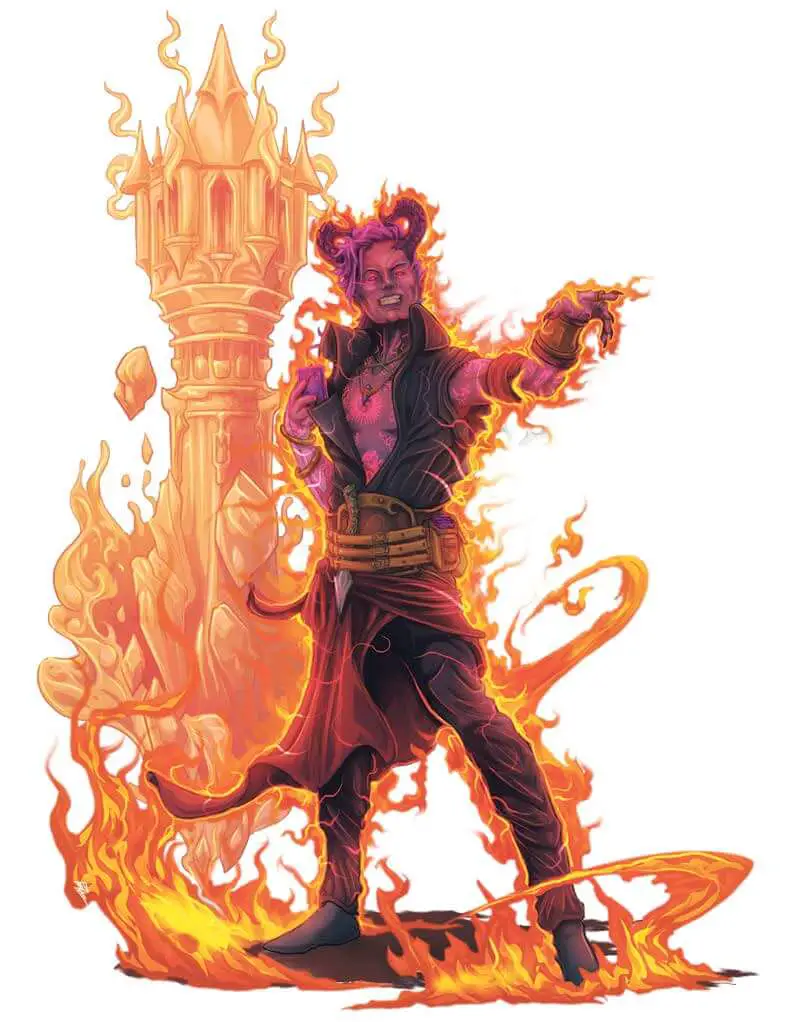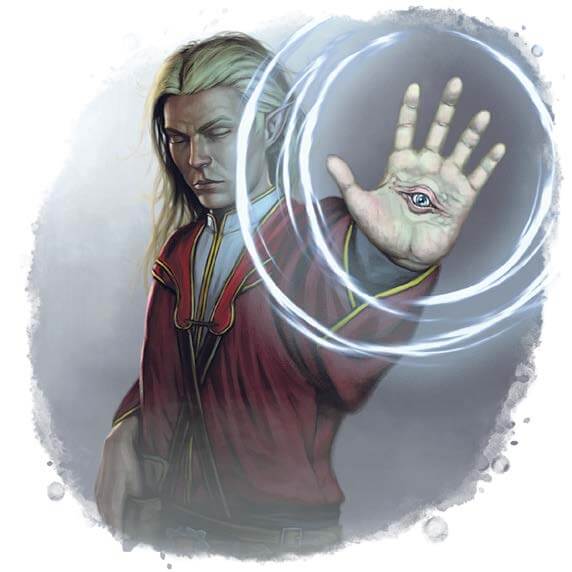Thaumaturge art is provided by Benjamin Huffman from commissioned artists for the Thaumaturge class content. This article contains affiliate links to put gold in our coffers.
I’ve been given a review copy of the D&D 5e Thaumaturge class by Benjamin Hoffman. The target audience for the Thaumaturge specifically would be people who are interested in making numerous character-defining decisions when building a character. The design is meant to engage players and keep their attention with its spellcraft features when it isn’t their turn.
The Thaumaturge goal is to be a class that feels like an archmage without being more powerful than other spellcasters. I myself made a Thaumaturge character whom I playtested and it was a lot of fun.
Thaumaturge Core Features (D&D 5e)
High level one, you get a subclass. You have spells known by spell school. You choose which spell school is going to be your primary spell school. Also, at first level, you pick your secondary spell school. You’ll get three more spell schools as you level up. You must remember you have an incentive to pick specific schools for primary, secondary, and tertiary because those come with your Tapestry’s Thread features. Some of the schools come with more useful features in this way.
This class uses Intelligence for spellcasting and it requires a 13 intelligence to multiclass.
You get Prestidigitation or Thaumaturgy as a cantrip and then you get to pick two cantrips from your Thaumaturge spell list. So don’t be confused because the Thaumaturge spell is whatever spell schools you’ve chosen.
Those become your Thaumaturge spell list. There’s this mechanic here that says, As you level up, you can choose one of the Thaumaturge spells and replace it with another.
Tapestry’s Thread.
You get Tapestry’s Thread at level two. The benefit is based on your primary school of magic right away, but you later get benefits from your secondary and tertiary schools of magic.
Several of the options are fantastic, but two of them stand out. If you choose abjuration, you get light armor and shield proficiency. With divination, you can add your proficiency bonus to your Initiative rolls.
It’s no secret that I love adding to my Initiative roles, especially in this case, because if I want a multiclass with Rogue, which is one of my favorite classes, I can combo Reliable Talent here.

Thaumaturge Spell Selection (D&D 5e)
While making my Thaumaturge character, I researched all the spells in the different spell schools to see which ones I really wanted.
One thing to keep in mind is that for something like, let’s say Divine Soul Sorcerer, a lot of players like that because you can get Cleric spells as a Sorcerer. The Thaumaturge can also do that for any spell-casting class as long as it’s on the right spell school. That somewhat overshadows the Bard’s Magical Secrets feature. You can get spells early that Ranger and Paladin would get much later, for example. You’re also able to cast healing and resurrection spells. Shucks, you can even gain Armor of Agathys as a full spellcaster or Eldritch Blast.
New Spells in the Thaumaturge Material for D&D 5e
Benjamin added a bunch of new cantrips and spells for all the different spells schools. This enables you with offensive cantrip options if you pick divination as your primary spell school, for example.
Several new cantrips and spells are extremely worthy.
10th Level Spells in D&D 5e with the Thaumaturge
Archmastery is the level-20 capstone. You can use Overcast to turn a 9th-level spell slot into a 10th-level slot to cast one of the level-10 spells included in the Thaumaturge supplement.
The 10th-level spells are impressive. I don’t know how many of them are based on just Benjamin’s original concepts and how many of them come from other places like old editions or anything like that. I recall in Rime of the Frost Maiden there was a scroll to summon the Tarrasque, and we do indeed get that in this supplement.

Thaumaturge Overcast Feature
Now at third level, we get Overcast. It interacts with your non-cantrips in two ways.
First, you can use it to upcast a spell. You cast one spell as if its spell slot had been one level higher.
Second, you can expand a spell slot and cast two spells at once. The sum of the two spell levels must be equal to or less than the spell slot you expend. This is a cool concept that gets around the Sorcerer’s Quickened Spell awkwardness where you couldn’t cast two leveled spells in a turn.
This gets stronger as you level up and have higher-level spell slots to expend.
There are other useful features as you level up, but I won’t get into those in this review.
Thaumaturge Subclasses
Each subclass is focused on… well, a unique arcane focus. It’s simple to quickly grasp the theme of each subclass. Let me explain how these subclasses all typically play out. They interact with you casting automated spells that require a spell slot and they give you resources.
Astrology

Astrologers cast a Thaumaturge spell to get a bunch of little pinpricks or stars equal to one plus the level of the spell slot. They orbit around your head, and then they stick around until you use a reaction. And when someone basically makes a d20 test, you can apply a bonus or a penalty to their role based on how many of your pinprick stars you want to spend.
So if I cast Polymorph fourth level, that gives me 5 little stars floating around my head. And then while I’m polymorphed into a giant ape, which is what happened during my playtest, I was able to still use those stars around my head. So I was a star ape. When someone was getting hit with an attack, I was able to say minus three or even up to minus five on that attack rule to try to make the miss.
And it worked; that felt good. All the subclasses are going to have something like that where you gain some stars or whatever fits the theme for those subclasses. And you can use them in a variety of ways based on that specialty and you gain some other cool features.
At level six, you can gain advantage on Wisdom Perception, and you can use a bonus action to gain blindsight until the end of your next turn. That could be really handy if you want to do a build where you’re utilizing Fog Cloud or Darkness or even Sleet Storm.
Cartomancy

This is your card-drawing spell caster, which has been a theme I’ve seen in 5e since it came out. First of all, that flavor is not really my thing. But the way that works here, I think Benjamin did a good job with it. Basically, when you cast a spell, you get to “draw a card” by rolling dice. You got a table of what those cards do, which is basically giving advantage or disadvantage to a type of D20 test based on what you draw.
It’s no action required though, so that’s nice. You don’t have to use your reaction or anything. Later, you gain advantage on this roll.
This subclass has another way to boost your Initiative. If you wanted to specialize in divination earlier, remember your divination tapestries thread would add your proficiency bonus to your Initiative role. So a sixth level will give you a plus three. And then gaining initiative advantage would effectively be a plus four to your Initiative. So you’re already getting good boosts to your Initiative.
And then Benjamin gives some optional rules for using actual cards instead of rolling a dx12 to see what card you draw.
Chandlery

You use candles, which I think is a great flavor. When you cast a Thaumaturge spell, you can make little flickers appear to help your allies with temporary hit points or to damage enemies. And it’s amplified if they’re in the bright light of the candle.
You produce the flicker and it’s a little bit weaker in the dim light produced by the light. There are very few mechanics in 5e that say if you’re in bright light versus if you’re in dim light, a certain thing happens. And then you can also reveal invisible creatures with the flickers.
Crystalmancy

When you cast a Thaumaturge spell that expends a slot, you get a crystal barrier around yourself represented by temporary hit points equal to three times the level of the spell you cast.
You’re making this crystal barrier around yourself that’s phantasmal. It’s ghostly, but then you can expend those temporary hit points as a bonus action to hurl crystalline shards at people. So I think it’s really cool. You can choose to defend yourself or go on the offensive with your bonus action. It’s always good to be able to weaponize your bonus action.
At level 18, your AC can’t be less than 18 and you have resistance to non-magical bludgeoning, piercing, and slashing damage all the time. There’s so much stuff at this level that would be magical, but this is cool.
When you die, your crystallized heart can be recovered and so I think that’s just a cool little thing that your heart becomes a gemstone at high levels.
Oneiromancy

This is kind of like your wild magic, even more so than the card-drawing subclass. You cast a spell, you create a kind of dreamscape area of effect that does something like give a creature flying, or give someone resistance to damage from spells.
If I were to play something wild magic, I would definitely play this over any of the wild magic options that are in 5e currently.
Tasseography

Pick a drink to cast spells with like potions! You pick a specialty drink that you make. Ale, coffee, tea, or wine.
If ale is your specialty, you can give them resistance and non-magical bludgeoning, piercing, slashing damage, and advantage on saving throws against being frightened. So that’s not bad. Coffee gives an advantage on Initiative rules. Tea gives them resistance to psychic damage and advantage on saving throws against spells.
Level six is like the Chronurgy Wizard 2.0. You can create a drink that is like a potion that has a spell embedded into it. Whoever drinks it becomes the person who concentrates on it and everything. So something that would normally be a range of touch or self is suddenly something you can give to someone else.
This is really good.
Spell Selection and New Spells
I won’t go through all the spells that Benjamin created and or compiled here, but I will just touch on a few of the cantrips to show how good they are.
First of all, Misfortunate Missile is a divination cantrip where you make a ranged spell attack, and if you hit you deal d6 damage. But before the start of your next turn, if the creature you hit with this Misfortunate Missile makes an ability check, attack, roll, or saving throw, you can use your reaction and just reduce it by a 1d4, reducing your enemies’ ability to pass a saving throw or hit an attack. This is one that I picked when I made my own Thaumaturge character.
I also like this abjuration cantrip, Repulsor Beam. You make a ranged spell attack and can push a target five feet away and deal two d4 damage and you can push them an extra five feet away based on your roll.
It’s critical to get more options for your Thaumaturge. If you look in the PHB for spells, you will see, oh, divination is not going to get me very much, but I really like the Tapestry’s Thread feature that I get for being a divination specialist.
Now you actually get some divination spells that aren’t just about gaining information from the DM.
My Thaumaturge Character Considerations
Let me tell you about the character I made and what was cool even if I didn’t pick them. Some of the spell schools and their spells that stuck out to me were if you pick abjuration, you get some cool cantrips like Repulsor Beam.

Abjuration
But from the PHB, you get things like Armor of Agathys if you want to just do like up-casting that two super high levels. You can get Protection from Evil and Good, Sanctuary, Shield, Aid, and Pass without Trace all at really low levels. And with abjuration, you get light armor and shields so you can boost your armor class.
Conjuration
You get a lot of summoning, but you also get things like FinD Steed and Find Greater Steed. When you’re seventh level, you can start writing a Pegasus that a paladin would have to wait until much higher levels to get. You can do Spirit guardians. At higher levels, you can gain Wish.
Divination
You can learn the Guidance cantrip and Gift of Alacrity for Initiative.
There’s also a new spell in the Thaumaturge that is Sense Danger, which is basically another bonus to Initiative. There are a lot of ways to boost your Initiative with this class. You can also gain Hunter’s Mark.
Enchantment
Enchantment can get you Bane, Bless, Command, Dissonant Whispers, Hex plus a lot of other cool spells.
Evocation
Later on, evocation can learn some cool cantrips like Green Flame Blade, Booming Blade, or Eldritch Blast. If you want to become something of a gish or a blaster, you also can get Guiding Bolt. A lot of people like that one. Healing Word is very useful. Wrathful Smite, Mass Healing Word, Holy Weapon, Mass Heal, or Destructive Wave can be cool.
You can gain Revivify, Spirit Shroud, Raise Dead, Resurrection, and True Resurrection.
Transmutation
Here are some good spells: Goodberry, Heat Metal, Spike Growth, Lightning Arrow, Plant Growth, Awaken, Reincarnate, Swift Quiver, Animal Shapes, Glibness, or Polymorph.
My Githzerai Character
The character I built was a Githzerai named Astrid Picasso. She decided to go with the Astrology subclass. I wanted to see how useful it was to be casting spells, reducing enemy rolls, and boosting ally rolls.
It wasn’t as broken as I thought. I was often casting cantrips, especially at lower levels, because I like to conserve my resources. Astrology stars don’t build up with cantrips. I tried to boost my Initiative as much as possible, so I had my proficiency bonus added to it, the d8 from Gift of Alacrity, and then the Sense Danger spell.
My Initiative roll was 8, but my total ended up being 25 at level seven. I had a pretty good Initiative bonus from all those spells.
My Final Review of the Thaumaturge
At first, I thought it seemed like a few over-tuned features. But then when I realized how fun it is to try to piece together the type of spellcaster I want, the more I came to enjoy it very much. Having playtested it, I realized some of the things I thought would be broken at low levels were good, but they meshed with the game just fine. They weren’t “broken” at all (though probably over-tuned).
There are impressive things you can accomplish with the Thaumaturge. At higher levels, you can achieve greatness with this class, especially based on some of the subclasses features, which you’re going to be excited about.
I want to go back to Benjamin’s target audience with this because I am the target audience. I love making numerous character-defining decisions and feeling like an archmage. It has been a long time since I dug into a new class or concept as much as I did this the Thaumaturge.
I created a spreadsheet and typed out all the different spells I could get if I chose different spells schools and how that would interact with Tapestry’s Thread. Did I want to get armor at low levels, or did I want a different primary spell school? Do I like the proficiency bonus to my Initiative rolls, or could I wait until later?
That sort of decision-making enlivened the game for me again. You don’t have to do a super deep analysis, but you still get to make numerous character-defining decisions. If you’re overwhelmed by making many decisions at once that will affect your character later on, this may not be for you.

Buy the Thaumaturge and Share Your Experience
So what do you think of it? Let me know if you try out the Thaumaturge based on my recommendation by casting Message in the comments. You can find more homebrew third-party content that I’ve reviewed or created here.
You can purchase the Thaumaturge class here and support third-party publishers like Benjamin Huffman/Sterling Vermin.
Have a great adventure this weekend!




